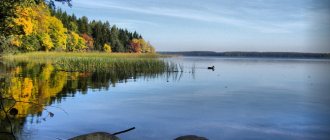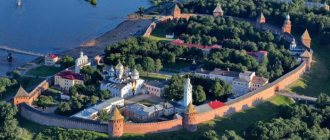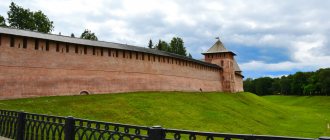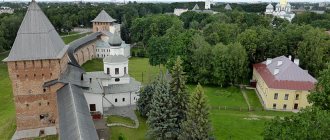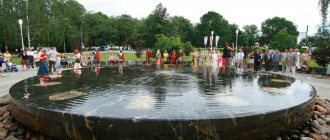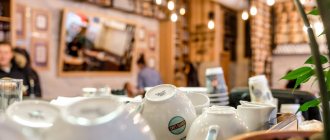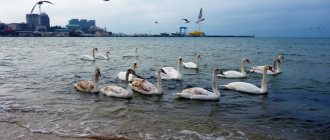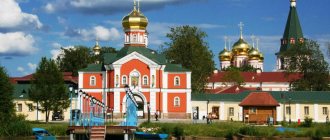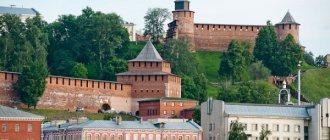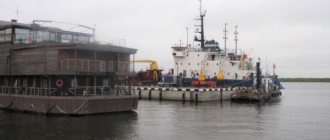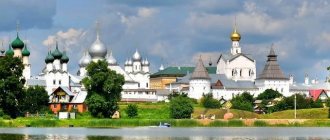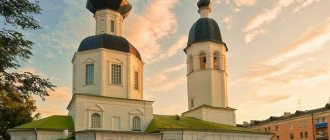Hello again, dear friends. I continue my report on my December trip to Veliky Novgorod. You can see the beginning here.
In this part of the report, read about the last three days of the trip, during which we managed to travel around the outskirts of Veliky Novgorod (St. Yuriev Monastery, Perynsky Skete, Museum of Folk Wooden Architecture “Vitoslavitsy”, Holy Trinity St. Michael-Klopsky Monastery, Nikolo-Vyazhishchi Monastery ), visit the cozy resort town of Staraya Russa (Museum of Local Lore in the Spaso-Preobrazhensky Monastery, House-Museum of F. M. Dostoevsky), and enjoy the magnificent winter nature of Valdai (Iversky Monastery, Museum of Bells).
As always, there will be a lot of photos. And at the end of the report, I’ll sum up the budget, give some recommendations on the route and share my plans for the next trip.
Third day: December 16
Saturday morning greeted us with heavy snowfall. Overnight, the landscape outside the window changed dramatically. Fluffy snow and light frost replaced the slush and greyness. The mood skyrocketed! Ahead of us were the sights of the outskirts of Veliky Novgorod.
We quickly cleared the car from the snowdrift that had formed overnight and went to the village of Yurovo (5 km). On the way we filled the tank full. We moved slowly, the ice was felt under the snow, and the ABS was activated every time the brake was pressed. But there were almost no cars, it was early morning on a weekend - the city was still sleeping.
St. George's Monastery
We arrived at the monastery just before dawn. There is stunning nature and ringing silence all around! Crystal clear air! We never ceased to be amazed at how lucky we were with the weather that day. However, look at the photo from the series: it’s better to see than to hear.
We arrived early, there were no tourists yet. We walked a little around the monastery territory, everything was well maintained, the paths were cleaned, the caring hands of the monks and novices were visible.
In the very center is St. George's Cathedral (1119). It's very cold inside. Stone floor and walls, no heating, damp and somehow alarming. It was difficult for me to be there, the cold literally penetrated to the bones, and the twilight brought on heavy thoughts. I didn’t want to stay for long; we quickly looked at the paintings, bowed, lit candles and left. Despite its antiquity, this place left some kind of heavy impression.
On the way out we saw a monastery shop. We bought delicious pies, straight from the heat (30-40 rubles). They learned from the novice that it was more convenient to go to the Peryn monastery first, and to the village of architecture after that. The question of the order of these objects tormented me even at home. It’s difficult to understand from the map, and the reviews somehow don’t reflect this point. We followed the advice and went to look for the Perynsky monastery.
Perynsky monastery
The Peryn monastery is located next to the monastery. Of course, it’s a bit far on foot, but by car we drove no more than five minutes. It is located, as it were, on an island; an artificial embankment connects this place with the shore. It is 300 meters long, but very narrow. And in winter, given the track, it is difficult for cars to pass there. We were lucky, there was no oncoming traffic, and the parking lot in front of the gate was completely empty.
I won’t tell you the history of this place; there is a lot of this information on the Internet. Just look at the photo.
There is a chapel in the center. You can put candles there and write notes. Services are held here once a week on Saturdays. The decor is simple, the atmosphere is homely, there is no pretentiousness of the central iconic places. Everything is simple and cozy.
I would like to add that all buildings are heated with wood. No civilization and very beautiful surroundings. The entrance is free.
Village of architecture "Vitoslavice"
But the village of architecture disappointed me. Reconstruction is in full swing there and there is almost nothing to see.
It took 10 minutes to get there. We parked at the Yuryevskoye Compound hotel. It is located opposite. It's more lively here. In front of the entrance there are many shops “for tourists” with souvenirs and clothes.
The Museum of Folk Wooden Architecture "Vitoslavice" is open from 10.00 to 17.00, the ticket office is open until 16.40. Entrance tickets: 150 rub. – adults, 100 rub. - students.
Note! Due to the reconstruction, there was no light in the entire complex for two weeks and no one from the administration gave any comforting forecasts on this matter. You won't be able to see the inside of the houses even during the daytime. The windows there are small, almost no light comes through, and flashlights don’t help.
50% of the objects are tightly closed with a high iron fence. Some are fenced off with red tape. The feeling is unpleasant, you walk as if on a construction site. In my opinion, it would be better to close the attraction altogether during renovations. There's almost nothing to see there now.
In general, to say that I was upset is to say nothing. I was saddened to tears, because these kinds of attractions are among my favorite ones. I will never forget the impressions that the village of architecture in Kostroma made on me during a tour of the Golden Ring. I hope that you, dear readers, will have better luck, but for me this is a reason to come back here again.
There is a small canvas café on the village grounds. You won't be able to have a proper meal there, but you can have a snack and drink hot tea.
By that time we were very hungry, so we went to the Yuryevskoye Podvorye restaurant; we really wanted some hot soup. Prices: a bowl of soup 250-300 rubles, hot dishes from 550 rubles. The interior is interesting.
The next point on the plan was to be the Staraya Russa resort. But due to the fact that it was already approaching lunch, the city is not close, and we need to return to Veliky Novgorod at least by six (we bought theater tickets), we decided to cancel the trip.
The freed time was devoted to visiting two more monasteries in the vicinity of Veliky Novgorod.
Holy Trinity Michael-Klopsky Monastery
This monastery is located 15 km from Veliky Novgorod along the Pskov highway. We didn’t know the exact address, so we typed the name of the monastery into the navigator and trusted fate. The gadget did not disappoint.
Already on the Pskov highway we noticed a sign to the monastery. The road is literally “in the field”. It is poorly cleaned, there are potholes upon potholes, but you can drive through even in a passenger car. We moved for six kilometers at a speed of 10-15 km/h, not a soul around, snow-covered fields on both sides.
We entered a village and domes appeared on the outskirts. I have never seen a more neglected and abandoned monastery; it’s amazing how, with such devastation, it is considered active?
There are no usual monastery walls there. A skewed fence, a poster and a change house at the entrance.
In the center is the Temple. Everything inside is scaffolded, apparently there were attempts to start reconstruction, but obviously there were no funds and the work was stuck without starting. It's a pity. The magnificent wall paintings show the grandeur of this place in ancient times.
The buildings next door are in even worse condition.
A small wooden Church was built on the territory, the only place where rare services are currently held.
In the monastery we met only one novice and talked with the priest, whom we found in the same hut at the entrance to the monastery.
I would like to hope that funds will still be found for the reconstruction of the monastery and that work will continue.
Is it worth going here? Depends on your preferences. I like to visit hard-to-reach, non-touristy places. If you share my passions, then you will like this monastery.
Nikolo-Vyazhishchi Monastery
It took about 40 minutes to get to the Nikolo-Vyazhishchi Monastery. It is located 30 minutes from Veliky Novgorod in the village of Vyazhishche, on the other side of the city. The navigator took a detour. The road was unpleasant, there was slush with ice under the wheels, although there were few cars.
This monastery is the complete opposite of the previous one, well-groomed and more pretentious or something. Already at the entrance to the village there is a stunning view of snow-white tall buildings and shiny domes.
The walls of the Cathedral are crowned with magnificent mosaics, which distinguishes the monastery from others.
The architecture of the complex of buildings reminded me of the Rostov Kremlin. The same powerful transitions between buildings, solid white stone stairs, the shape of the windows. A very interesting place, I recommend visiting it.
It was not possible to get inside the Temple immediately. At 16.00 it was closed. But when we walked around the territory they noticed us. Father opened the Temple, allowed us to bow and light candles. He told me a little about the life of the monastery.
Drama Theater: play Deceivers
We returned to Veliky Novgorod around 6 pm. An hour was enough for us to change clothes and rest. We purchased tickets to the theater immediately upon arrival. I really wanted to see a performance by a local troupe. On December 16, the comedy “Deceivers” was on for the second day, the hall was full. Obviously, the residents of Veliky Novgorod enjoy the cultural life of their city. And that's great!
Much has been written about the history of the theater building itself; from the outside it made a depressing impression on me. Everything inside is quite modern, although of course there is no escape from the architecture of the second half of the 20th century.
The performance itself left me indifferent. I can only say that it seemed to me that the actors were overacting. And I didn’t like the plot itself, maybe that’s the whole point. I apologize in advance to theatergoers for such a biased opinion; I very rarely go to theaters and I’m unlikely to be able to professionally assess the level of performance.
The girls were happy. True, Natalya has already seen this performance on the Moscow stage. Her opinion was not so categorical, but she also spoke about a more modest execution of the plot by the local troupe.
In any case, we did not regret going to the theater; the mood was wonderful. We returned to the hotel satisfied. A difficult day lay ahead of us. Still, we decided to visit Staraya Russa on the way to Valdai. To do this, we needed to make a huge detour, but we wanted to complete the program in full. Therefore, we had dinner in our room and went to bed early, expecting to get up at six in the morning.
Points on the map: why go and what you must see in Staraya Russa
In outline
Where to stay
Where to relax
How to get there
What to see
Where to eat
In outline
The first name of the city most likely came from the Porusya River (formerly simply Rusa) - at its confluence with the Polist River, ancient tribes once settled. It is not yet possible to find out even the approximate date of the emergence of Staraya Russa. Archaeological artifacts hint that people settled here at the turn of the 10th-11th centuries, but the scientific world was not used to bowing to shaky evidence, so the first mention was considered the starting point.
The chronicle of 1167 tells how a certain Yakun Andreevich with the Novgorod army moderated the claims of the former Novgorod prince Svyatoslav, who cynically ruined Torzhok and came close to Ruse. As a result, Svyatoslav never mustered up the courage to conflict with the real army and retired home.
There is also a birch bark document that is almost a hundred years “younger.” Two local guys immortalized their names in it - Boyan and Zhitobud “from Rousy”, who owed someone a hryvnia each. This means that the city already existed. This is confirmed by archaeological finds from the corresponding layer: wooden pavements from the 10th century, tools for extracting and evaporating salt from mineral springs, as well as handicrafts. Apparently, the choice of a new date for the founding of the city was a demonstration of respect for the hard work of archaeologists - in 2015 Staraya Russa celebrated its millennium.
River Polist. Photo: Depositphotos
But further chronicles pour in as if from a cornucopia. Ancient soil scientists, trained to read and write, unanimously report on the construction of temples, the construction of a fortress in the location at the turn of the 12th-13th centuries, the unsuccessful Lithuanian raid in 1234 and other interesting events.
A Muscovite in another city: what surprises residents of the capital when traveling around Russia
By the first half of the 15th century, Rusa had already become a rich city with a settlement. The location on the trade route “from the Varangians to the Greeks” formed a strong merchant layer and serious “state salt production” here. Ten churches are known to have been built by this time, five of which were stone.
Claudius Lebedev “Martha Posadnitsa. Destruction of the Novgorod Veche", 1889
From the middle of the 15th century, Moscow began to show aggression towards the Novgorod lands - Rusa was ravaged and burned twice. Particularly tragic was the return home of the Rushans, who were temporarily hiding in Novgorod in 1471 during the Battle of Shelon. After the Korostyn Peace Treaty, entire families with livestock and all their belongings loaded onto one and a half hundred ships. However, a storm unexpectedly came and Ilmen-Lake received the souls of about seven thousand people. And soon Rusa, as part of the Novgorod possessions, nevertheless went to the Moscow principality.
In the 16th century, Russia flourished - the duties it paid to the treasury exceeded the taxes of all the largest cities of the Moscow kingdom. Under Ivan the Terrible, the city became Staraya Russa and was distributed into the oprichnina lands, which saved it from the abuses of the tsar’s personal guard.
Walking around Moscow:
Bolshaya Nikitskaya and Pokrovka
But the 17th century practically destroyed all the previous achievements of local salt industrialists. Actually, the bad luck began with the Polish-Lithuanian raids in 1581, when the city was ravaged and burned. At the beginning of the century, Russa attracted the attention of False Dmitry II and his army, then fell into Swedish occupation and was literally finished off by epidemics - by the time the Stolbovo Peace Treaty was adopted in 1617, the city had 38 inhabitants instead of eight thousand. Then the king issued an order to populate the location with inhabitants of other cities.
In the 18th century, the mobility of Peter I, who visited Staraya Russa twice, contributed to the revival of the salt industry. The young king’s appetite for oak wood also had to be satisfied—the state needed shipbuilding yards.
From Moscow for the weekend: Peredelkino
7 cities to which you can escape from Moscow by bus
Under Catherine II, the city traditionally, as if by order, was destroyed by fire in 1763, after which the “random” flammable development was optimized by “reasonable” planning in accordance with the urban planning reform of the Empress. The district of Staraya Russa was granted a coat of arms, which symbolized the main source of city income - salt production, as well as its affiliation with the Novgorod province.
The 19th century was marked in the history of the city by a brutal cholera riot. Poet N.M. Konshin informed A.S. Pushkin about secret events in Staraya Russa, which at that time had the status of a military settlement:
“Now it’s as if I were at least a thousand years ago, my dear Alexander Sergeevich. The bloody scenes of the darkest ignorance before our eyes are reread, verified and convicted. How fierce in their bitterness are the good Russian people! They pity and torture; they call you nobles and beat you with clubs, and all this together. Damn it, this is like nothing else! Our people are considered smart, but not a spark of common sense is visible here.”
Alexander Sergeevich, in turn, reported with horror to Vyazemsky about the officers, including generals, who were “cut with all the subtleties of malice,” as well as the doctors who were killed and buried alive in the ground, who had been treating these people for decades and helping at the birth of their children.
However, the key event was the opening of the mineral springs resort in 1828.
A beautiful park laid out around local lakes, fountains and the effectiveness of medical procedures, proven by doctors Fedor Gaaz and Yegor Raukh, made recreation on the local “waters” fashionable and extremely popular. Grand dukes, critic Nikolai Dobrolyubov, artist Boris Kustodiev, Konstantin Stanislavsky, Maxim Gorky and many other representatives of the aristocratic, creative and political elite of that time came here. The modern coat of arms of Staraya Russa
The resort turned out to be so popular that to entertain vacationers, a summer theater was built according to the design of the architect Benois. It was here that the unknown artist of the Vilna Theater Vera Komissarzhevskaya became popular and got a chance for a brilliant career. After a touring season in Staraya Russa, she was engaged by the management of the imperial theaters - she was taken to Alexandrinka.
For eight years in a row, Fyodor Dostoevsky and his family came here to the dacha. They were attracted by the local cheapness, the community, the waters and the beauty of the landscape. “It’s true that the place is lakey and damp, this is known, but what to do...” Fyodor Mikhailovich wrote to his sister.
Gorky Park is 93! How the “factory of happy people” developed
During the Great Patriotic War, Staraya Russa was occupied by fascist troops for two and a half years. Fierce battles took place here, residents were tortured, there were gallows everywhere - a city with a population of about thirty people, hiding in basements and attics, had to be liberated. All businesses - hospitals, libraries, shops - and many houses were completely destroyed, the historical settlement was practically destroyed. Staraya Russa received the title of City of Military Glory.
Photo: wikimedia
Today it is a city of regional significance. Here, the buildings of the mud and mud baths were rebuilt, new wells were drilled, and two types of mineral waters were discovered. The leading enterprises are considered to be aircraft repair, instrument-making, chemical engineering and medical-instrument factories.
How to get there
The distance from Moscow to Staraya Russa along the highways is about 600 km (455 km in a straight line). The best way to cover this distance is by train. The branded Pskovsky 010A will take you directly to the point, from 2000 rubles for a seat in a reserved seat. True, the schedule for those who do not go to the final destination is extremely inconvenient. Already at 4.30 in the morning you will be at the railway station, in addition, you will have to pay for an extra night in a hotel and another day will be spent restoring energy.
Experienced tourists advise artificially prolonging the journey on train 042A Moscow - Veliky Novgorod (departure at 22.07 - arrival at 06.24, price for a reserved seat from 1548 rubles), get to Staraya Russa by bus in two hours (according to the schedule for 1 hour 25 minutes) and 250 -350 rubles.
Staraya Russa station. Photo: wikimedia
There is also the ghost train 298A, which runs on an extremely flexible schedule, the meaning of which can only be known to the railway gods. For example, in November-December it travels towards Pskov on Tuesdays and Fridays, in January - from the 2nd to the 9th, in February for two days. But this is the only daytime option - it leaves at 15.36.
Other materials from the series:
Points on the map: why go and what you absolutely need to see in Russian cities
As for moving by car, you need to choose one of two popular routes. The first is to follow the Volokolamsk highway (M9 highway), at the fork to Staraya Toropa in the Tver region, turn to Toropets, through Kholm and Poddorye and then easily get to the desired point. The second option is for fans of toll roads: along the M11 through Tver, Vyshny Volochek, Kresttsy and Zaitsevo. Here it is worth checking in advance the availability of gas stations at paid areas - you may need to stock up on fuel.
Where to stay
Photo: hotel community VKontakte
Hotel Visavi
Address
: Mineralnaya st., 59A
Price : from 2600 rubles per double room per night
Nice modern hotel ten minutes walk from Cathedral Square. Cozy and familiar to the eyes of Muscovites, European-style rooms, garden views, free parking, comfortable attic Studios for families with children. You can bring your favorite cat or other pet. The hotel also has a sauna and SPA complex.
If there are free rooms, it makes sense to get a valuable service: rent a room for half a day, for those who still arrive directly from Moscow at four in the morning. You can’t make a reservation, but you can most likely make an agreement in a day or two. Some reviews complain about unfriendly staff, which is strange for a tourist city. If you take care of early booking, it is quite possible to keep within two thousand per night.
Photo: hotel community VKontakte
Hotel Polist 3*
Address : st. Engelsa, 20
Price : from 2500 rubles per double room per night
First, about the positive aspects. The location is excellent - 500 meters to the main attractions. The room has a hygiene kit with shampoo and shower gel. The reception is quiet and the staff is friendly. There is private parking, you can bring pets, and the breakfast is varied and delicious.
However, the guests' complaints also seem justified and do not resemble the whims of spoiled capital residents. The rooms do not have air conditioning - it is hot in summer and cold in winter. You need to ask the receptionist for a hairdryer, but the telephone in the room may be faulty. The area of the rooms and bathrooms is very small, although you just need to know about this in advance; the area is honestly indicated on the website. The manager is asked to think about purchasing new towels, bed linen, and partially carpeting. And the main disadvantage is poor sound insulation. People claim that if there is a wedding in a hotel restaurant, you are unlikely to be able to sleep.
Photo: wikimedia
AMAKS sanatorium "Staraya Russa"
Address : st. Mineralnaya, 62
Price : from 3750 rubles per double room with breakfast per night
An excellent place with rave reviews - it may well serve as the main purpose for coming to Staraya Russa. The price of the room includes three meals a day, basic health services (health path, climate therapy, drinking therapy, barefoot therapy), access to lectures, a children's room and a peasant farmstead.
The decoration of the rooms was clearly done by a separate designer, and not by a manager with “good taste” - European style, spacious, bright rooms with magnificent views. It's great that some buildings allow pets. By the way, several buildings are named after famous guests who came to the fashionable resort or lived in Staraya Russa and its environs: “Rachmaninov”, “Dostoevsky”, “Glinka” and “Mendeleev”.
What to see
Resurrection Cathedral. Photo: wikimedia
Iconic architecture
Ancient temples fit perfectly into the landscape of the ancient city, reflected in the mirrors of its rivers and lakes. Even if your goal is not pilgrimage and, in principle, not religious tourism, it is still worth admiring the architecture of buildings with ancient history and touching prayer stones for aesthetic pleasure.
Resurrection Cathedral (Vozrozhdeniya St., 1) - the calling card of Staraya Russa - rises with a bright accent at the confluence of Polist and Porusya. It was erected at the end of the 17th century on the site of the ancient churches of John the Baptist and Intercession. The cathedral was rebuilt in the first half of the 19th century according to the design of V.P. Stasov, giving it a Russian-Byzantine look. The bell tower offers a breathtaking view of the city, especially in summer and winter.
Spaso-Preobrazhensky Monastery. Photo: Depositphotos
The Spaso-Preobrazhensky Monastery (Monastyrskaya Square, 1) attracts with preserved frescoes of the 15th-17th centuries and a centuries-old history - excellent guides will tell you about it. There is also an exhibition of paintings, which, by the way, is strongly criticized due to the inappropriateness of the exhibition in a religious institution, as well as a local history museum - a common phenomenon for small towns. The stone cathedral was built here at the end of the 12th century: it was rebuilt many times, but the foundation is the same - remembering the prayers of Abbot Martyrius, at that time already the Archbishop of Novgorod. You can climb the bell tower to see the domes in detail, as well as the carved runners and curbs on the light drum. And once again admire the surroundings of Staraya Russa.
The parish church of the Dostoevskys is interesting - the Church of St. George the Victorious, originally built in 1410. The five-domed St. Nicholas Church with a bell tower, the cubic temple of Mina the Martyr, the active Church of the Holy Trinity - lovers of unglamorous antiquity will definitely like the object, and touching the eternal stones can experience peace.
Photo: wikimedia
House-Museum of Dostoevsky
Address : emb. Dostoevsky, 42/2
In the year of the 200th anniversary of Fyodor Mikhailovich, it is hardly possible to walk through the house-museums of his memory alone. However, you still need to take a look. This was Dostoevsky’s first personal home, who constantly wandered around rented apartments. On his first visit, Fyodor Mikhailovich appreciated the cute town.
“We’ll probably hire in Staraya Russa, especially since there are so many amenities - cheapness, speed and ease of moving and, finally, a house with furniture, even kitchen utensils, a station with newspapers and magazines, etc. and so on,” he shared with his sister.
Spouses and children came here in the spring and stayed until late autumn. Most of “The Brothers Karamazov” and Pushkin’s speech were written here, and here the writer spent the last summer of his life. The exhibition contains authentic things of the writer; it is best to take a tour.
Not just buildings: 15 Moscow house-museums of writers
Photo: wikimedia
Water tower
Address : Cathedral Square
Rainy Moscow: where to spend cloudy weekdays and weekends
At the beginning of the 20th century, the Bryansk Plant Society laid the first ten-mile-long water supply system across the city. The hexagonal red brick water tower in Art Nouveau style adorned Cathedral Square and became one of the key symbols of Staraya Russa. The structure with a granite pedestal was badly damaged during the war; it was restored only in 2022. Now from the 38-meter height of the observation deck you can look around the city, and on the second and third tiers you can get acquainted with the exhibitions.
Where to relax
Photo: museum website
Brew salt in the “Estate of the Medieval Rushanin”
Address : st. Svaroga, 44
An interactive space with a working salt pan, recreated buildings and household items of Rushan of the 12th century. You can take part in boiling the salt yourself, taste it (they say it’s different from store bought salt) and bring it home in a souvenir jar with a wooden spoon. This is a rare type of educational recreation that is suitable for both adults and children. It’s better to take a guide, but if you don’t like excursions with jokes, download the audio version in advance.
Then you can simply wander along the ancient street of Svarog, formerly Pyatnitskaya, and look into the writers' park - appreciate the monument to Dostoevsky by sculptor V. Klykov, erected 20 years ago.
Cities through the eyes of residents: what unobvious places are hidden from tourists
Photo: wikimedia
Spend a day at the Staraya Russa resort
Address
: Mineralnaya st., 62
Dedicating a day to wellness detoxification, disconnecting from social networks and being surprised to discover that the world is beautiful - you can try all this at Staraya Russa; the quiet space of the resort complex as a whole is quite suitable. You just need to schedule the day of the procedures in advance: swim in the aquatic center, smear yourself with therapeutic mud, sweat in the Finnish, Turkish and infrared saunas, arrange autogravitational unloading of the spine, breathe salt in the halo chamber, and so on.
Or just take a walk through the beautiful park, drink mineral water and meditate on the ten-meter-high spray of the self-flowing Muravyovsky fountain. In both cases, it's an excellent plan for recovery.
Comfortable environment: 7 cool glamping sites near Moscow
See the ruins of the Buregsky Monastery and the Psizha River
Address : Starorussky district, village. Burega
Cultural vacation: 5 cities near Moscow where you can immerse yourself in the world of contemporary art
The unusual Psizha River is a picturesque place, where it is, of course, better to come in the summer. Turbulent, with a bottom of rocky limestone, it flows into Lake Ilmen, where about 50 other rivers flow.
Lovers of unrestored, dilapidated antiquities come here. Admire the graceful forms of the 18th century Resurrection Cathedral and the bell tower, make your way through the windfall to the destroyed St. Nicholas Church, decipher by the outlines whose faces the artist painted on numerous frescoes. Until the 70s there was a fertilizer warehouse here, and in the 80s reconstruction began, but perestroika froze the idea.
Visitors note that the place has powerful energy and evokes thoughts about life and the Universe - most often elegiac. However, as they say, if you are not sad, you will not be happy.
Where to eat
Photo: community of the establishment VKontakte
Cafe - Kalachi - Bar
Address : emb. Dostoevsky, 3
Average bill
: from 500 rubles
Nice place with a veranda and wood-burning pizza oven. Reviews are polar: for some everything is good and tasty, for others it is bitter, sour and “not very fresh”. The prices look modest, but all guests note that the portions are very small. There is a themed menu. For example, on the occasion of the 200th anniversary of F.M. Dostoevsky serves dishes mentioned in his books: pike perch with mushrooms will cost 440 rubles, tongue in sour cream sauce with potatoes will cost 310 rubles, and cherry pie for dessert will cost 210 rubles.
Almost all guests agree that the cafe is highly recommended for a lunch snack. And the view of the water tower brightens up the taste flaws even for anxious visual learners.
Photo: VKontakte cafe community
Cafe "Tower"
Address
: Gostinodvorskaya st., 2
Average bill : from 900 rub.
Judging by the reviews, the best establishment in the city. People praise the fast service, delicious dishes and reasonable prices. Almost no one grumbles about a tired interior, calling it cozy and familiar. The menu is standard, but there are also interesting dishes. Baked pumpkin with feta and arugula will cost you 310 rubles, boyar soup with rasstegay - 290 rubles, tiger shrimp with ginger and garlic - 700 rubles.
Craft Pub 1984
Address
: St. Petersburg st., 10
Average bill for beer : from 250 rubles
The atmospheric spot with great reviews opened in March 2020 and seems to be holding up well during the pandemic. The interior here is modern—one that would be quite suitable for a metropolitan pub; a small but very well-chosen menu, there are even vegan dishes.
All guests enjoy the wide selection of craft beer and burgers and call the food “very tasty” - a rarity in these unkind pandemic days. The room is small, with books and board games. Burgers (there are even ones with chickpeas and vegetable cutlets) cost from 270 rubles, excellent tom yum - 290 rubles, meat shawarma - 250 rubles.
Day four: December 17
Road: Veliky Novgorod – Staraya Russa
That day we had to travel more than 300 km, so we didn’t have time to relax in bed in the morning. We quickly had breakfast with porridge from bags, quickly got ready and left the cozy Sofia Hotel.
It was sad to leave Veliky Novgorod. It's a pity that we didn't get to see a lot. In my mind, two days is not enough to explore the city and its surroundings; at least one more day was not enough. But there are only two days off and the road from Moscow is not close, we could not afford such luxury. In addition, I really wanted to see the beauty of winter Valdai. In general, I had to choose.
From Veliky Novgorod to Staraya Russa it is about 100 km. The road was decent, despite the weather conditions we drove quickly, there were few cars in the morning, I didn’t see any cameras, and we didn’t meet any traffic police officers. We got there without incident.
Staraya Russa
Museum of Local Lore in the Spaso-Preobrazhensky Monastery
We decided to start with the Spaso-Preobrazhensky Monastery. When drawing up the plan, I did not pay attention to the fact that the monastery is not active. Therefore, we were very surprised when the navigator took us deep into residential buildings. In the middle stood the old Temple without any monastery walls, fences or associated buildings.
As we got closer we saw a small sign saying “Museum of Local Lore”, and on a nearby building “Art Gallery”.
The local history museum is located in the building of the Spassky Cathedral, built in the 12th century. This time we paid for the guide. The prices for the excursion are ridiculous: 320 rubles. from a group of 1-10 people. 45 minutes. Entrance tickets: 100 rub. adults, 50 rub. children.
The excursion did not disappoint. In 45 minutes we learned the history of the city from antiquity to the present day. Very interesting, I recommend it. See photo.
We didn’t go to the Art Gallery; time was running out.
Church of the Great Martyr George the Victorious
On the way to the Dostoevsky Museum we came across the Old Believer Church of the Great Martyr George the Victorious.
Judging by the sign, it was built in 1410, and rebuilt in 1740, preserving the foundation. This Temple was the main parish of the family of F. M. Dostoevsky.
As you can see, at the moment the Temple is in excellent condition. There were many parishioners, there was a service going on, so it was not possible to photograph the decorations inside. They didn't stop there.
House Museum of F. M. Dostoevsky
Within walking distance from the Temple, in a beautiful place on the very bank of the river, is Dostoevsky’s house, where the writer spent his last days.
The house is in very good condition. Most of the furniture has been preserved from that time. Very cozy bright rooms. Some kind of warm atmosphere, I wanted to stay and live here.
And Luda actually said that she had always dreamed of just such a house for her family. No new projects are needed, take the layout as a basis and build.
Entrance tickets: 100 rub. — adults, 50 rub. — students. At the entrance, you are given a tour guide with a story about the writer’s life and a detailed description of the interior of each room. This is enough to present the complete picture.
The House-Museum of F. M. Dostoevsky left a very positive impression. I recommend a visit to everyone, both adults and children.
Road: Staraya Russa – Valdai
We stopped in the resort part of Staraya Russa for literally five minutes. We took several photos.
It’s difficult to find parking there, so we didn’t linger and went to Valdai. The navigator paved the way through Kresttsy, although it was probably closer to drive through Demyanovo. But we didn’t take any risks, for fear of getting stuck on bad country roads.
To bypass Lake Ilmen, the road winds strongly. The first 20 km the quality of the track is terrible. Further on it was better, but still we got to Pervomaisky somehow. There was really not much traffic, the slush alternated with ice, and the ruts on the turns did not allow relaxation. I didn’t see any cameras in this area; there was a forest around, through which a lake sometimes appeared on the left.
When we got onto the familiar M10 it became more fun. In Krestsy we had a snack of pies and tea from the samovar. Local residents provide this service right on the road. The tea is incomparable, but after the fatty fried pies with cabbage I had heartburn. However, perhaps only my stomach reacted this way, and I’m in vain sinning by obviously using the same oil a hundred times when frying.
The traffic here is of course more intense, there are a lot of heavy trucks. However, the track was dry, the road conditions allowed driving 100 km/h, so we arrived in Valdai at 13.30.
Valdai
Holiday home "Losiniy Tupichok"
For an overnight stay in Valdai, we chose a house in the village. I didn’t want to pay dearly for a decent hotel for one night. There are not many accommodation options in this place. Hostels did not suit us.
I found and booked this vacation house on Booking. By following the link you can see the current prices. What attracted me most was its location. On the map it is the closest of all the available options to the Iversky Monastery. And of course, the relatively low price played a role (2820 rubles/day).
30 minutes before approaching Valdai (passing through Kresttsy) I called the owner. When we arrived, they were already waiting for us.
From the outside the house doesn't look very good. An absurd building, though with a cozy courtyard where there is a bench and barbecue.
Enough space for a couple of cars.
The owners live in a house in the neighboring yard; after receiving the keys, we never saw them again. Peace and quiet are guaranteed to you here. Everything inside looks just like in the photo. Clean and comfortable. You can comfortably accommodate 5 people. But more than that, it will be a bit cramped. On the ground floor there is a kitchen-living room with a comfortable wide sofa.
A steep staircase leads to the second floor. There are two small single beds. It will be a bit cramped for a couple to share a bed, more likely for one person.
Note! There is no door between the first and second floors, almost a single space.
Pros: quiet, comfortable beds, clean, kitchen with all necessary appliances, cozy courtyard.
Among the significant disadvantages: the declared Internet did not work, the water is not suitable for drinking, washing is also unpleasant (rotten smell), a cold dressing room between the toilet and the rooms.
A good option in terms of price/quality ratio for spending a weekend in nature, quite suitable for a vacation if you have a car.
Overall we were pleased. We quickly got comfortable in the kitchen, rested for an hour and went to the Bell Museum.
Bell Museum
Back at home, I read that the Museum of Bells is the only one in Russia, and it is located in Valdai. We couldn't miss such an attraction.
It didn't take long to search. It was no more than five minutes from our house.
The museum is located in two buildings. We visited only one, time was running out, we still wanted to get to the Iversky Monastery before dark.
Probably should have taken a tour. But for some reason we didn’t take it. This was a mistake; in this kind of museum there is no entertainment that replaces the story. All bells look similar. It seems nothing special. That is why an interesting story from a professional is necessary, otherwise there is nothing to do there.
The museum is open from 10.00 to 18.00, closed on Tuesday. We visited the part that is located in the building of Catherine's Church (1793). A very beautiful place, Lake Valdai can be seen in the distance.
Entrance tickets: 100 rub. — adult, 50 rub. - children's. You can buy “single”. It includes a visit to two buildings of the Museum of Bells and the Museum of the County Town (250/120 rubles adults/children).
Iversky Monastery
After walking around the area a bit, we went to the Iversky Monastery. The journey took 15 minutes and we had to take the M10. After three or four kilometers we saw a sign to the monastery. Next is a picturesque part of the path. There is a snow-covered forest around, through which Lake Valdai periodically peeped through. The nature around is amazing!
The Iversky Monastery is located on the island. But there is a road from the mainland; it is not difficult to get there by car.
The parking lot is huge. There are several buildings nearby where you can find a store and toilets.
Opposite the entrance to the monastery there is a pier. Apparently in the summer, ships ply here.
The monastery itself occupies a large area. It is clear that the funding for this facility is at a high level. Everything is polished: building facades, paths, lanterns - the surrounding decoration simply screams of prosperity. There is a very big contrast between the previous monasteries.
We walked there for a long time. It's already dark.
It was time to return home. But the girls wanted smoked fish. And on the way to the Iversky Monastery, we came across a small cafe, whose advertising promised tourists exactly this dish.
Of course we stopped by. The interior is, to put it mildly, unusual. Standard cabin in the forest. But how lovingly and stylishly furnished it is. Of course there is not enough space inside. The cafe is designed more for the summer season; there are many tables outside. But in winter you won’t be able to stay there for long.
We didn’t want to stay in the cabin for dinner. We just bought fish and went home to feast.
The evening passed in intimate conversations. The next day awaited us on the way home, separation, and return to everyday life. So the evening tea dragged on for a long time, we discussed the trip, shared impressions and dreamed of a new trip, no matter where, as long as it was together and with an interesting program.
Staraya Russa
Staraya Russa is a city of flower shops and funeral homes. Here, under the canopy of weeping willows and chestnut trees, the graceful Polist slowly carries its waters, and local canteens serve Buratino lemonade for six rubles per glass. All this is so wonderful that you immediately want to drink sweet soda, give some beautiful Rushanka a bouquet of flowers, walk with her along a quiet embankment overgrown with trees, and then die with a calm soul. Well, maybe before that you can also smear yourself with healing mud at a local resort, but this is not for everyone.
I came to Staraya Russa for the aeronautics festival, so I didn’t have time for all the above-mentioned entertainment - I only managed to run back and forth through the vegetable gardens a couple of times, avoiding the crowds of tourists, of which there were surprisingly many here.
No, of course, I knew that in Staraya Russa there is one of the oldest balneological and mud resorts in Russia. But I was sure that it had long been forgotten and abandoned by everyone. It turned out that the resort in Staraya Russa is not only not abandoned, but is even thriving. There are a dozen buildings on the territory, several relatively large hotels in the city center, a couple of small guest houses - and there are practically no places anywhere. And I thought it was a quiet province...
The province turned out to be really quiet after all. And although the tourists in the city are like uncut dogs, they all either cluster around the resort area fenced with a high fence, or explore the second main attraction of Staraya Russa - the Dostoevsky house-museum. By the way, both of these places of interest ultimately passed me by.
While I was flying in a hot air balloon, the scout I sent there, Dimon, was studying the resort. As soon as I landed, reconnaissance reported: the task was completed, there was nothing decisive to look beyond the fence. And we went to the Dostoevsky Museum. There, after hanging out in the cramped lobby with a couple of tourist groups, we bought two magnets from the ticket office instead of two tickets to the museum, and, pleased with ourselves, went for a walk around the city.
Here I cannot help but notice that next to the Dostoevsky Museum there is one of the most beautiful places in Staraya Russa - a miraculously preserved old cobblestone street laid along the river. No granite embankment, no parapets, no benches, no pseudo-Dostoevsky lanterns - only cobblestones and old willows bent over the surface of the water. Unfortunately, I didn’t think of photographing this miracle, although I probably should have - I’m afraid in a few years everything might be different there...
In general, Staraya Russa is one of the oldest Russian cities. It is located on the Polist River, at the confluence of the Porusya River (sometimes also called Pererytitsa).
Residents of Staraya Russa are called Rushans.
Despite it being Saturday evening, the city greeted us with silence; there were almost no drunks on the streets.
The balloon festival was in full swing. The balloons, solemnly launched from the central stadium, flew off into the distance, and only a large airship remained in the sky, leisurely floating back and forth over the city center.
In addition to the balneal and mud resort and the Dostoevsky Museum, Staraya Russa is famous for its temples. The most famous of them is the Resurrection Cathedral.
Once upon a time, the history of the city began from this place: there was a fortified fort here on the cape. Well, the first temple appeared here only in the 17th century. It was rebuilt several times, the last time almost two hundred years ago according to the design of the architect Stasov.
The Resurrection Cathedral had a particularly turbulent history in the 20th century - in Soviet times it managed to be a local history museum, which, by the way, has now moved to another cathedral, and a military museum, and a stable, and a club, and a cinema - in general, a rich biography , you can't say anything. Since the early 1990s, the building has again served its religious functions.
I have always been touched by the juxtaposition of recently restored Orthodox churches and Lenin monuments inherited from the USSR: so different - and yet together. Usually such a neighborhood is the first sign that you can find a lot of interesting things in the city.
My experience did not deceive me: Staraya Russa really had something to surprise. What was it worth at least for the episode when Dimon and I, having drunk a fair amount of Abkhaz wine, stood on the terrace of our guest house and enjoyed the Russian rock music coming from some neighboring gardens, performed to the accompaniment of an accordion.
The Resurrection Cathedral is, of course, beautiful. I’ve never been a fan of the pompous Russian Empire style, especially when it appears before me in the form of religious objects, but there’s definitely something in this temple.
By the way, the cathedral was painted in a bright brick-red color quite recently, just a few years ago. Before that, it was yellow for a long time.
You don’t even have to go anywhere to find beauty in Staraya Russa, it’s right in the air. For example, everything that has to do with the city is denoted by the possessive adjective “Old Russian”. Romance!
Starorussky district. Old Russian cheese. Old Russian vandals.
And although the latter do not sleep, in architectural terms Staraya Russa also has something to boast about.
On the central square - Sobornaya - there is an old water tower, built a hundred years ago, just then the first water supply system appeared in the city.
In Soviet times, this square bore the name of the Revolution, and before the revolution - Trade Square: Old Russian, Novgorod, Tver, Suzdal and Moscow merchants have long met here.
We walked leisurely, munching on pies bought at a nearby stall. A drunken woman was sitting on a podium that had appeared out of nowhere in the middle of the square: “Hey, guys, tell me the time?!”
Here, in one of the neighboring buildings, two new contenders for the title of “best window in the world” were unexpectedly found.
In general, from an architectural point of view, Staraya Russa is a post-war city. When it was liberated by Soviet troops in February 1944, there was not a single resident and practically not a single intact building left.
Having been rebuilt almost from scratch in the post-war years, this city somehow miraculously managed to preserve its Soviet, slightly neglected, but amazingly kind atmosphere. I thought that it could only be found in old films. But no - welcome to that Staraya Russa!
Lilacs are fragrant and chestnuts are blooming everywhere.
Chestnuts! Where did you last see blooming chestnuts in St. Petersburg? And in Staraya Russa - please, on every corner!
The buildings are gradually falling into disrepair.
Along with them, in order not to stand out, the old sidewalks, which have not seen repairs since Soviet times, also fall into disrepair.
The city lives its own life.
The walls of old Russian houses are decorated with the most elegant indicators of distances to hatches, drawn by hand. If you look closely, you can see their previous interpretation under the faded paint. I wouldn’t be surprised if there are several more ancient layers hidden underneath it.
Staraya Russa is very green. And very quiet. Even to me, who has been living in the countryside for eight years now, this silence seemed unnatural - it doesn’t get so quiet in cities.
An old wooden bridge leads to the opposite bank of the Polisti. It is located on the site of an ancient crossing. Once upon a time, this bridge was floating and swayed when loaded; because of this feature, the name “Live” was assigned to it. That's what they call him to this day.
After the revolution, the communist machine mercilessly swept through the cities of the USSR, renaming most of the streets, avenues and squares in a new way. The Old Russian communists decided to break away in a special way: when the surnames of party leaders for street names ran out, they turned on their imagination at full capacity, and this is how toponymic masterpieces like the October Events and the Proletarian Victory appeared. However, recently the process has reversed, and some streets have begun to be returned to their historical names.
Among all this communist schizophrenia, Svarog Street stands apart. The owner of the guest house where we lived told a funny story: some time ago, almost a scientific expedition came from Moscow to study the history of the name of this street. Imagine their disappointment when it turned out that the ancient Slavic god had absolutely nothing to do with it, and the street got its name in honor of a local artist who worked under such a pseudonym at the dawn of the USSR.
In the center of the city, between the Soviet four-story buildings and the vegetable gardens of local residents, the Spaso-Preobrazhensky Monastery has stood since the 12th century.
Let's climb the former bell tower. Let's look in one direction.
Then - to another. Let's be sad.
There are several museums located in the former monastery buildings. One of them is an art gallery of the same artist Svarog.
The second is a quite interesting local history museum.
Here you can learn the legend about Rus and Sloven - the epic ancestors of the Russian people. According to legend, in the middle of the 3rd millennium BC, the ancestors of the Slavs left the shores of the Black Sea and reached Lake Ilmen, in the north of which Sloven founded the city of Slovensk (now Veliky Novgorod), and in the south Rus founded the city of Rusa (now Staraya Russa ). In the legend you can find many other interesting episodes: about the Slavs’ campaigns against Egypt, and about negotiations with Alexander the Great, and about the visit of Apostle Andrew to Rus', and about much, much more, right up to Gostomysl’s calling Rurik to reign. In general, a most interesting work, even if it appeared only in the 17th century. Although, in fairness, different variations of this legend were found in various chronicles earlier, starting from the 10th century.
If we talk about more authoritative sources, then Staraya Russa was first mentioned in the middle of the 12th century. AD, of course. At the same time, archaeologists believe that already a hundred years before this, Rusa (that’s what the city was called until the 17th century) was already a developed settlement with wooden pavements and dense urban development.
From the very moment of its foundation, Staraya Russa was under the influence of Novgorod, until in the 15th century the city came under the rule of Moscow. All this time, Staraya Russa was an important center of salt production and trade.
At least twice in its history, the city was ruined almost to the ground - first, in the 17th century, the Swedes frolicked here very well, then in the 20th century - the Germans.
In the local history museum you can see an interesting collection of birch bark letters found on the territory of the city - ancient Russian mail, used until the 15th century.
Here, for example, is birch bark letter No. 10, dating from the 12th century: “This is a letter from Yarila to Onania. In Gorodishche, your domain, there is only water to drink (there is nothing left to eat). And the Rushans (residents of Rusa) mourn for the town residents. If you want, intimidate the nobles so that they don’t do anything dirty!”
But much more interesting is birch bark document No. 35, also from the 12th century.
It consists of two lines. First line: “From Radoslav to Choteslavow. Take ou prasol 2 hryvnia and 5 kouno.” Second line: “Yakov brother, fuck lying down, fuck, fuck.”
Next is a brief interpretation of the letter. Radoslav gives instructions to his brother Hoteslav: “Take 2 hryvnia and 5 kuna from the prasol (merchant).” Hoteslav categorically does not like this instruction: perhaps his brother is sending him to prasol instead of simply paying off his debt. He answers sarcastically and without hesitation in the form of expression. The address “Yakov brother” (and not “Radoslav”) is apparently ironic or even sarcastic: Khoteslav calls his brother not by his secular name, but by his baptismal name, and even with the word brother, which is appropriate only in a church or in a particularly solemn situation, but not in any way combined with the subsequent rudeness of “fuck lying down”. The latter carries the meaning - “Don’t be original, be like everyone else!” To this expression, Hoteslav adds two more intricate epithets for Radoslav-Jakov: “ebehota” - lustful, and the less clear “aesova” - most likely a compound word from “ae” - egg - and “sovati” - to poke.
Well, that's brilliant! There are no words. Nowadays they no longer know how to swear so gracefully.
By the way, this little document refutes the theory that Russian swearing appeared only during the Mongol-Tatar yoke. Fuck you, fuck him lying down!
Well, to conclude my story about Staraya Russa, I can’t help but tell you about the mineral springs. There are eight of them in the city, and all of them were drilled by hand.
The most famous of them is the Muravyovsky fountain, located directly on the territory of the resort. This is the most powerful mineral spring in Europe. Today it looks like an ordinary fountain, although in the old days an elegant pavilion was built above it (image credit).
I visited two lesser-known springs located on the outskirts of the city.
The first of them is Tsaritsynsky, drilled in the middle of the 19th century. It is just a huge rusty pipe sticking out of the ground. By the way, the depth of the well is 246 meters.
The second is Catherine's. It is located about fifty meters from Tsaritsynsky and is significantly inferior to it in power. It is unknown when it was drilled.
That's all for today.
Don't switch!
Continuation: A story about those who do not look for easy ways
Day five: December 18 - way home
I have long noticed that the road home always seems longer to me than the road to vacation. The distances seem to be the same, but for some reason it’s more difficult to drive. This fact is probably influenced by the emotional state. After all, when you go on vacation, you go in anticipation of something new and unknown, and when you return, you think about everyday worries and problems. Sadness is added here, the journey ends.
In general, this time the way home was no exception. We left Valdai at 9 am. The traffic was quite intense, there were a lot of trucks. But you can easily get around them; the road often turns from one lane to two.
There were cameras in all settlements; it was impossible to break the speed limit. In general, we drove slowly and carefully. It was still quite slippery in the morning.
We pulled out onto the first toll road and only then realized that we only had a quarter tank of gas. I didn’t want to move out right away, we hoped it would be enough. We go, we go, but it doesn’t end. We were flying 120 km/h, no oncoming traffic, no passing, nothing. They saw the workers and stopped. They said that the next exit to the M10 with gas stations is about 50 km away. And our gas gauge has already dropped.
What to do in such a situation? The repairmen offered two options: to stay and wait for the help they called, or to move on, hoping that the still splashing fuel would be enough to reach the treasured gas stations. We chose the second option. And you won’t believe it, the car stalled right in front of the barriers. And just opposite there was a building where the mobile emergency service was located, servicing this paid area.
The emergency crews said that we were very lucky. According to the plan, they have a control tour of the territory every four hours, they just returned from there. So, if it weren’t for the “happy accident,” we would have had to wait for them in the cold for a long time, because of course none of us wrote down the emergency phone numbers.
Life doesn't teach me anything. I’m giving you advice, but for the second time I’m stepping on the same rake. After all, less than six months have passed since the summer trip to Abkhazia, where the same situation with gasoline occurred. If you are interested in the details of the summer trip, read here.
This time, too, everything ended well for us. The “commissars” filled us with 7 liters for 300 rubles. Everything is official, with a receipt and signature on the delivery note. You could say they saved us. Very nice guys. Thank them very much!
Then we moved as usual. There were no traffic jams, the traffic was heavy, but working. Before reaching Tver, I got tired and relaxed a little. After the toll road, I forgot that there were also traffic lights.
The result showed immediately: a sharp brake at the intersection and driving beyond the control line. And of course, traffic police officers. I didn’t see their dear ones all the way, I just had to disturb them a little, and they were right there – standing right behind the intersection. Naturally, they stopped me and, of course, they issued me a fine of 800 rubles, 400 of which I paid immediately upon arriving home.
Actually, these are all incidents on the way back. In Solnechnogorsk there was a bit of jostling, and we also drove around Moscow for a long time along the Moscow Ring Road. But this was all predictable and we did not expect anything else.
The entire journey from Valdai to Lyubertsy took 7 hours. We arrived at the place around 16.00.
How to get to Staraya Russa
Motorists from Moscow will have to travel 530 kilometers along M-11 to Staraya Russa. You can plan a visit to the city on the way to Veliky Novgorod and Valdai.
From Moscow you can also come here by train in the direction of Pskov from Leningradsky Station in about 9 hours. From St. Petersburg there are regular buses from the bus station and minibuses from the Moskovskaya metro station.
- Train timetable Moscow – Staraya Russa
- Bus schedule St. Petersburg – Staraya Russa
It’s easier to get from St. Petersburg - 317 kilometers and about 4 hours by car through Veliky Novgorod and then around Ilmen.
You can get from Veliky Novgorod to Staraya Russa by bus in 1.5 hours.
How much did you spend?
Initially we planned a budget trip. From the series: nothing superfluous, the less the better.
The numbers indicate only myself. I also took into account that the cost of the road there (1900 rubles for petrol + 750 rubles for tolls) was divided into two, and gasoline on the spot and on the way back - for three (1000 rubles for petrol there + 2150 rubles for additional costs + 750 RUR road fee). The cost of housing was simply divided by three. We ate mostly at home. Having summed up the receipts from the grocery store and rare cafes, I received the total amount for food.
- Road – 2625 rub.
- Housing – 3950 rub.
- Entrance tickets, excursions and theater - 2140 rubles.
- Meals – 2715 rub.
- Fine – 400 rubles. : for three = 135 rub.
Total: 11575 rub.
I didn't buy any souvenirs. The only thing I didn’t take into account in the final figure was notes and donations in Temples. But this is a personal expense item. And without them, the trip cost about 12,000 rubles. That's roughly what I originally planned to spend.
Where to stay in Staraya Russa
For those who want to take a break from stress and heal with local waters, the best accommodation option is the Staraya Russa sanatorium of the AMAKS network with an aquatic center. But having settled in other hotels in the city, you can also visit the aquatic center and drinking pump room, so tourists have a choice - for example, the modern Visavi Hotel located opposite the gates of the resort park or the Polist Hotel on Engels Street with a beautiful view of the park.
And in the vicinity of the city there are many recreation centers intended for lovers of fishing and countryside recreation: “Brown Bear” in the village of Khmelevo, “Retlyo” in the village of the same name, near the beach on the shore of Lake Ilmen.
Recommendations for followers
Oddly enough, given the poor preparation for the trip this time, I don’t have any special complaints or corrections after the fact. I have already given several recommendations in the first part of the report, here are some more tips for the route:
- If you want to see more in Veliky Novgorod, or “don’t rush” to get acquainted with the local attractions of the city and surrounding area, then add at least one more day to your trip. Ideally, you need to set aside at least three days to study everything interesting. Two to Veliky Novgorod itself, and one to interesting places in the surrounding area.
- If you are very limited in time, you don’t have to go to Staraya Russa. The town certainly deserves attention, but no more than any other provincial town in Russia. This step will allow you to spend an extra half a day in Veliky Novgorod, or enjoy the magnificent nature of Valdai longer. Still, Staraya Russa is quite a big detour on our route.
- Buy food in shops at monasteries. If you have accommodation with a kitchen, this is a good food option. Their products (dumplings, dumplings, eggs, sour cream, twists) will allow you to eat nourishingly and tasty. And the cost is no more expensive than chain stores.
Stripped off the sticky
Along with the beautiful Resurrection Cathedral of the late 17th century and the hundred-year-old water tower, these linden alleys were one of the attractions of the central part of Staraya Russa. They were dropped off by soldiers and civilians returning from the front - in a common desire to revive their beloved city from the ruins.
Bricks from the destroyed buildings were then used to restore the school and build dugouts. And in place of the ancient buildings, linden alleys were laid, which became a kind of living monument to the revival of the city.
Meanwhile, ruthless pruning is not the arbitrariness of the builders, but a stage in the implementation of a promising project to create the Starorussky tourist cluster - an event of the federal target program "Development of domestic and inbound tourism in the Russian Federation" (2011-2018), which includes the reconstruction of Cathedral Square and the organization six-kilometer tourist walking route. As part of this project, more than 300 million rubles were invested in the improvement of Staraya Russa in 2022.
The reconstruction of the square began in earnest last year. The original project involved completely uprooting all the trees, thereby almost doubling the size of the area. But the Old Russians insisted on preserving the lindens, emphasizing their importance in the historical memory of the city. and in February last year, at the request of the public, changes were made to the project developed by the creative workshop of the Novgorod architect Valery Perepelitsa.
The head of the Starorussky district, Vasily Bordovsky, did not forget to repeat at every opportunity that the authorities listened to the opinion of the people. Imagine the surprise and indignation of those same people when “horns and legs” remained from the saved linden alleys. People simply did not have time to do anything - they began beheading the lindens when the entire square, right up to the embankment of the Polist River, was behind a high fence of reconstruction builders and access to it was prohibited. Moreover, earlier work was carried out to form the crowns of trees growing on Voskresenskaya Street, which runs parallel to Cathedral Square. The linden trees there have already been crowned - why not give them a beautiful spherical shape again. No one could have imagined that someone would encroach on the shady linden alleys separating Voskresenskaya from the square. Over the course of 70 years, they have grown to almost the size of a five-story building.
But when the fence was removed in mid-January, people saw real stumps in the depths of the construction site. And then the municipal authorities completed the decapitation of four rows of linden alleys in a few days.
— It was decided not to leave such a multi-level “boot” between the renewed square and Voskresenskaya Street (somewhere it was cut off, and somewhere it was overgrown). And we gave the task to level the tree crowns,” explained the head of the Starorussky district, Vasily Bordovsky.
The official is confident that he did not break his promise to preserve the linden alleys, but in fact he pronounced a death sentence on the trees. Only delayed. Work on crown formation is not carried out during winter frosts. As Elena Kiseleva, a practicing specialist in the field of landscaping and landscaping, said, the crown of mature trees, even in favorable weather, can only be shortened by a third. And not overnight, but over two seasons. In our case, God forbid, if one third is left alive.
Rushanka Nelly Aleksandrovna Guseva (she is already 80 years old) cannot look at what is happening without tears:
“The linden trees that the girls and I planted after the war and which we looked after for years are now sentenced to destruction. I don't believe they will survive. You can’t prune them in winter!
You cannot trim, leaving only “pillars”. There will be no more linden alleys in the city center...
Seeing what the would-be lumberjacks had done to the alleys adjacent to the square, the townspeople tried to save at least what had survived. Letters demanding to stop the work were sent to the administration and the prosecutor's office. The head of the district, Bordovsky, under the pressure of public opinion, promised not to cut off the remaining linden alleys. And he even complained that the Uyut specialists seemed to be not even very good specialists; they lacked professionalism. Otherwise, they would have left more branches on the linden trees they were pruning.
The Old Russians no longer believe it and listen with bated breath to see if the sound of a working chainsaw will be heard again over the Polist River in the center of the ancient city.
Direct speech
Elena Evdokimova, Candidate of Biological Sciences:
— At negative air temperatures, the trunks freeze. And the larger the cut, the more dangerous it is for the survival of the trees. No means for processing saw cuts work at sub-zero temperatures, so frost-damaged tissues die. And when temperatures above zero occur in dead plant tissues, a decomposition process occurs due to fungal and bacterial infections. The most likely is infection with spores of tinder wood-destroying fungi, which subsequently leads to damage to the entire plant, even to its death within several years.
Number
239 limes
barbarously circumcised in Staraya Russa.
